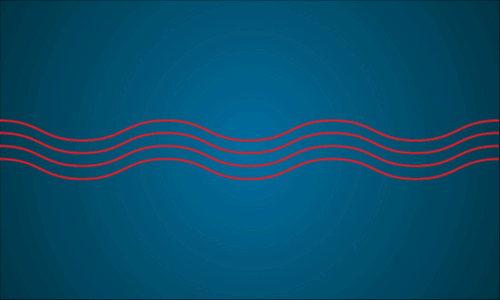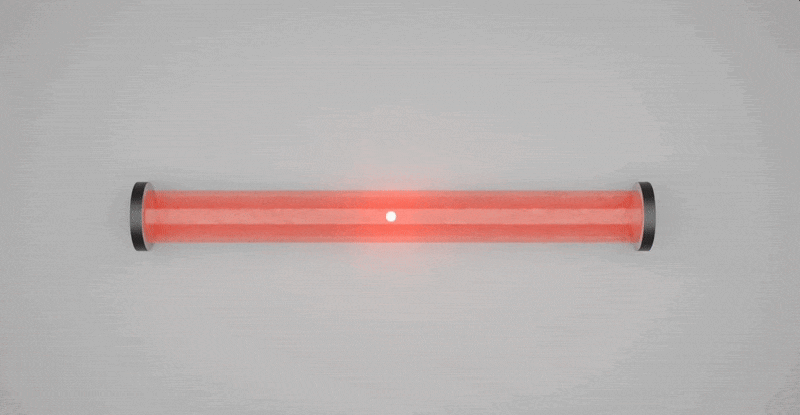How do laser pointers work?
The short answer
Laser pointers work by exciting atoms so their electrons release light. Mirrors inside the device amplify that light and force the waves to move together in a single direction, creating a narrow, focused beam that can travel long distances without spreading out.
The long answer
Regarded by cats and dogs as the most elusive prey, laser pointers are a fascinating display of physics at work.
But before we get into the technology of laser pointers, let's first nail down what exactly is a laser.
What are lasers?
If you compare a laser pointer to a flashlight, you'll notice a few key differences. While both produce light going in one direction, a flashlight's white light spreads out the further it is directed. A laser pointer, however, produces a very narrow, bright beam of single-color light that stays directed no matter how far you point it.
This animation shows how a laser's light waves behave. Its wavelengths are the same length and oscillate together. Source: NASA
This is what makes lasers special. A laser's light waves are very similar wave lengths (which gives them a single color) and travel in sync, forming a narrow, powerful stream of light.
How do lasers work?
Fun fact: The word "laser" is actually an acronym standing for Light Amplification by the Stimulated Emission of Radiation. This acronym contains clues for how lasers work. 🔎
Let's start with a quick refresher on the basic structure of an atom. An atom contains a nucleus surrounded by orbiting electrons. The electrons are found at fixed distances from the nucleus. As you go farther out, the electrons at higher levels have more energy.
If an electron gets stimulated with extra energy, it temporarily moves up an energy level, and then quickly return to its normal orbit, known as the "ground" state. When the electron returns to its ground state, it releases that extra energy as light.
This is the Stimulated Emission of Radiation part of LASERs. Lasers work by stimulating electrons to release light as they return to their ground state.
Okay, so that's part of the acronym, but what about the LASER part?
Recall that laser light waves move in sync and travel in one direction (Note: I didn't intentionally mean to namedrop two famous boy bands, NSYNC and One Direction, but maybe they should join together to form a band called LASERs).
To achieve this effect, we need to bring in mirrors. A typical laser contains a rod—often ruby crystal—with mirrors on both ends and a flash tube wrapped around it. One side is a full mirror and the other is partially open to allow light to be released.
A laser has mirrors at both ends, but one side is only partially reflective so light gets out. Source: "How Does a Laser Work? (3D Animation)" by 3D Requiem
When you click the button on a laser pointer, the flash tube lights up and provides that initial stimulation of the ruby atoms' electrons.
As the stimulated electrons release light, they stimulate other electrons causing a chain reaction. The mirrors bounce photons back and forth, amplifying the light and keeping it aligned. In short, the mirrors achieve the Light Amplification needed to make lasers work.
Source: "How Does a Laser Work? (3D Animation)" by 3D Requiem
Breaking it all down, a laser works because of the physics phenomenon of stimulated electrons releasing light when they return to their ground states. Mirrors are added to amplify the light created in this process and direct the light waves to move together.
If there are any cats or dogs reading this, I hope you now understand the red dot is not your enemy. It’s just physics. Uncatchable, taunting physics.
Curious about how the world works?
Today You Should Know is a free, weekly email newsletter designed to help you learn something new every Friday.
Subscribe today 👇
Check out some other curious questions:
Sources
3D Requiem. (2024, March 24). How Does a Laser Work? (3D Animation). YouTube. https://www.youtube.com/watch?v=RQUFOA_8LZg&ab_channel=3DRequiem
deGrasse Tyson, N., & Nice, C. (2019, October 31). How Lasers Work, with Neil deGrasse Tyson. YouTube. https://www.youtube.com/watch?v=t9jtGHXgQvw&ab_channel=StarTalk
Lawrence Livermore National Laboratory. (n.d.). NIF’s Guide to How Lasers Work. National Ignition Facility & Photon Science. https://lasers.llnl.gov/education/nifs-guide-how-lasers-work
Libretexts. (2025, March 21). 5.12: Energy Level. Chemistry LibreTexts. https://chem.libretexts.org/Bookshelves/Introductory_Chemistry/Introductory_Chemistry_(CK-12)/05%253A_Electrons_in_Atoms/5.12%253A_Energy_Level
NASA. (2021, February 4). What Is a Laser?. NASA. https://spaceplace.nasa.gov/laser/en/
Philipp, T. (2021, October 15). How does a laser work? - Mr Beam explains. Mr Beam Lasers. https://www.mr-beam.org/en/blogs/news/how-does-a-laser-work
Thompson, J. (2024, March 29). How do lasers work?. LiveScience. https://www.livescience.com/physics-mathematics/how-do-lasers-work
Woodford, C. (2024, November 28). Lasers. Explain that Stuff. https://www.explainthatstuff.com/lasers.html










It’s like an American accent but with calendars.